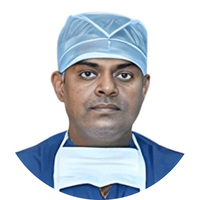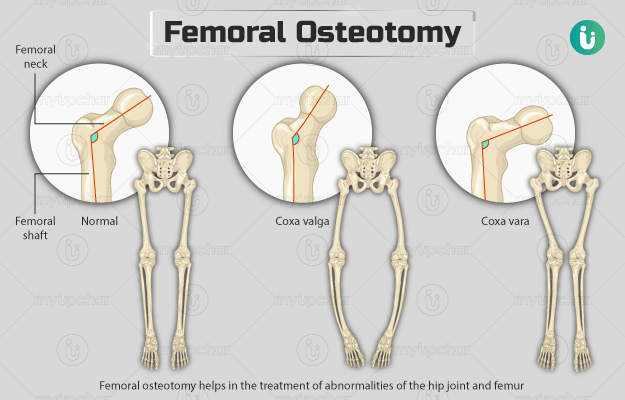Summary
Femoral osteotomy is a surgery performed to treat abnormalities in the hips joint or femur.
Before the surgery, the doctor will take your complete medical history and order a few diagnostic and imaging tests. The surgery will be done under general anaesthesia. During the surgery, an incision will be made on the outer side of your hips, a section of your femur will be cut off, and the bone will be placed in the correct location.
After the surgery, a hospital stay of about four to five days will be required, and physical therapy is needed. You can walk in about six weeks, but initially, you will need a walker to provide support.
A follow-up will take place in about one to two weeks; however, contact your doctor if you notice symptoms such as fever or redness and swelling at the operation site.
- What is femoral osteotomy?
- Why is femoral osteotomy recommended?
- Who can and cannot get femoral osteotomy?
- What preparations are needed before femoral osteotomy?
- How is femoral osteotomy done?
- How to care for yourself after femoral osteotomy?
- What are the possible complications/risks of femoral osteotomy?
- When to follow up with your doctor after a femoral osteotomy?
What is femoral osteotomy?
Femoral osteotomy helps in the treatment of abnormalities of the hip joint and femur.
Femur is the long bone of the thigh. It has a curve at its top known as the femoral neck and a round head above it that fits perfectly into the socket (cavity) of the pelvis known as the acetabulum. Together, this forms the ball and socket hip joint. The hip joint is encapsulated by a cushioning cover called articular cartilage which reduces friction and absorbs shock.
The angle between the shaft of the femur and femoral neck is known as version and is normally 12 degrees to 15 degrees forward. If the rotation of the femoral neck is excessively forward, a person will tend to walk with their toes turned inwards (towards each other) to achieve stability in the hip joint. Additionally, he/she will have discomfort in hips and a risk of developing arthritis among other risks. On the other hand, if the rotation of the femoral neck is excessively backward, the person will walk by turning their toes outwards.
If the angle between the femoral neck and the femoral shaft is increased, the condition is known as coxa valga, whereas coxa vara is a condition in which the shaft and neck is decreased. These conditions may also require surgery as they can cause degeneration of the hip and pain.
These rotational or version misalignments are found commonly in females than males and may be present since birth or may develop due to an injury or fracture in the femur. In such conditions, surgery will be advised to cut the femur so that it realigns into the hip cavity.
Why is femoral osteotomy recommended?
The surgery may be recommended in the following cases:
- Hip abnormality at birth (such as the rounded part at the top of the femur not fitting well in the socket of the hip)
- Walking with toes inward or outward-facing
- Legs are of different lengths
- An abnormally healed fracture in any of the bones in the hip joint
- Severe spasticity (contraction) in the hip muscles causes the head of the femur to come out of the socket over time, causing severe pain and deformity. It can be observed in conditions like cerebral palsy, spinal cord or brain injury, and multiple sclerosis.
- Developmental dysplasia of the hip (a condition wherein the hip joint does not form properly)
Some symptoms of developmental dysplasia of the hips include:
- The affected femur may be shorter
- The skin folds between the legs at the top of the thighs may be unequal
- Walking on toes
- Limping
- Stiff joints with pain
- Hip pain
The surgery may also help in delaying the need for hip joint replacement.
Who can and cannot get femoral osteotomy?
The contraindications for femoral osteotomy include:
- Inflammatory disease
- Instability in knees
- When the toes are outward-facing by more than 20 degrees
- Severe loss of bone mass
What preparations are needed before femoral osteotomy?
The following preparations are required before femoral osteotomy:
- Your doctor will take your medical history and perform a physical examination. You will undergo a few diagnostic and imaging tests such as blood tests, magnetic resonance imaging (MRI), and computed tomography (CT) scan. These will help the doctor assess your femur, hip and overall health and ensure that you are fit enough for the procedure.
- If you take any medications (over-the-counter or prescription) or supplements, tell your doctor about them. Discontinue medicines like aspirin, ibuprofen, warfarin, or clopidogrel as they can cause problems with blood clotting. You will also need to stop taking supplements.
- You will be asked to fast from the midnight prior to the surgery. Fasting is essential to prevent vomiting (risk of general anaesthesia) during the surgery.
- Your doctor may ask you to quit smoking before the surgery to help you recover afterwards.
- Arrange for a companion to take you back home after the surgery.
- You will sign a consent form if you agree to the procedure.
How is femoral osteotomy done?
After you arrive at the hospital, the hospital staff will ask you to undress and wear a hospital gown. They will insert an intravenous (IV) line in your arm or hand to provide you with essential medicines and fluids during the surgery. Your body will be attached to different devices to monitor your blood pressure and heart rate.
In the operating room, the following steps are performed for femoral osteotomy:
- You will lie on your back on a medical table, and general anaesthesia will be administered to make you fall asleep.
- The surgeon will make a long downwards incision (cut) on the outer side of your hip.
- He/she will use x-ray imaging to decide the location of the femur that is to be cut.
- Once the location for the cut is identified, the surgeon will use a special tool called osteotome (a chisel-like instrument) to cut the femur.
- Then, he/she will place your femur in the proper position and rotate it, as required to the correct angle, to fit the femoral head into your acetabulum perfectly.
- The surgeon will attach a plate to the top of your femur with the help of pins or screws to align it into your hip joint and keep it in place while it heals.
- Finally, he/she will close the cut with stitches. The sutures will be made under your skin so their removal is not required.
Once the surgery is complete, you will be shifted to a recovery room where you will be closely monitored. The hospital staff will give you pain medicines to help reduce the discomfort. Fluids will be given intravenously to you until you can eat and drink on your own. To improve your recovery, the doctor will encourage you to eat and drink after the surgery. You will be taught a few exercises to help prevent blood clots in your legs.
Rarely, a cast will be required after the surgery, but in children, if the bones are soft and their repositioning appears unstable, a cast may be used. However, in most cases, soft padded bandages will cover the surgical cuts. Your legs may be spread out by placing soft, pillow-like devices between them.
You will stay in the hospital for about four to five days. A second surgery may be needed to take out the plate attached during osteotomy.
How to care for yourself after femoral osteotomy?
During recovery, keep these points in mind:
- Physical therapy: Initially, two to three sessions of physical therapy per week will be recommended for a minimum of six weeks.
- Walking: If you could walk without any support before the surgery, you may need to use a walker for some time afterwards. However, if you required walking support before the surgery, you will need additional support now. You should be able to walk better in about four to six weeks after the surgery.
- Pain management: You will be on narcotics (addictive medicines to reduce pain and induce sleep) for one to three weeks after the surgery. You may otherwise take non-steroidal anti-inflammatory drugs (NSAIDs) such as paracetamol.
- Driving: You will be able to start driving three to four weeks following the procedure once you have stopped taking pain medicines.
- Work: You may be able to start work two to three months after the surgery.
- Activities: Your doctor may suggest you avoid running, jumping, and carrying heavy weight for at least six weeks post-surgery as they quickly cause wear and tear of the hip joint.
When to see the doctor?
Go to the doctor if you see symptoms like:
When to follow up with your doctor after a femoral osteotomy?
A follow-up will be scheduled in one to two weeks to check your progress after the surgery. During the visit, your doctor will also conduct an X-ray to assess the operated area and healing process.
Disclaimer: The above information is provided purely from an educational point of view and is in no way a substitute for medical advice by a qualified doctor.
Surgery Cost In Your City
Doctors for Femoral osteotomy

Dr. Manoj Kumar S
Orthopedics
8 Years of Experience

Dr. Ankur Saurav
Orthopedics
20 Years of Experience

Dr. Pritish Singh
Orthopedics
12 Years of Experience

Dr. Vikas Patel
Orthopedics
6 Years of Experience
References
- Saint Luke's Hospital [Internet]. Kansas City. US; [link]
- Hospital for Special Surgery [Internet]. New York. US; Femoral Osteotomy: An Overview
- St louis Children's Hospital [Internet]. Missouri. US; Femoral Rotational Osteotomy
- American Association of Neurological Surgeons [Internet]. Illinois. US; Spasticity
- Cerebral Palsy Alliance [Internet]. New South Wales. Australia; Signs and Symptoms of Cerebral Palsy
- University Hospitals of Leicester [Internet]. NHS Foundation trust. National Health Service. UK; Treatment for developmental dysplasia of the hip (DIH)
- UCSF Health [Internet]. University of California San Francisco. California. US; Preparing for Hip Replacement Surgery
- Hernandez A, Sherwood ER. Anesthesiology principles, pain management, and conscious sedation. In: Townsend CM Jr, Beauchamp RD, Evers BM, Mattox KL, eds. Sabiston Textbook of Surgery. 20th ed. Philadelphia, PA: Elsevier; 2017:chap 14
- Nemours Children’s Health System [Internet]. Jacksonville (FL): The Nemours Foundation; c2017; What's It Like to Have Surgery?
- National Health Service [Internet]. UK; Having an operation (surgery)
- U Health [Internet]. University of Utah. US; Corrective osteotomy: Hip & Knee















